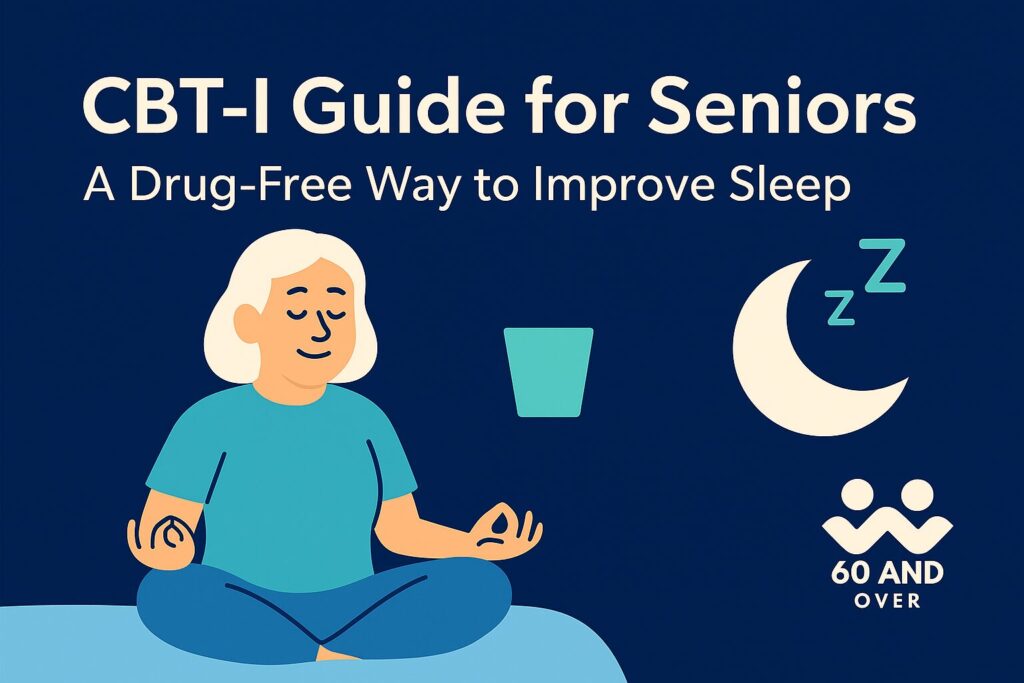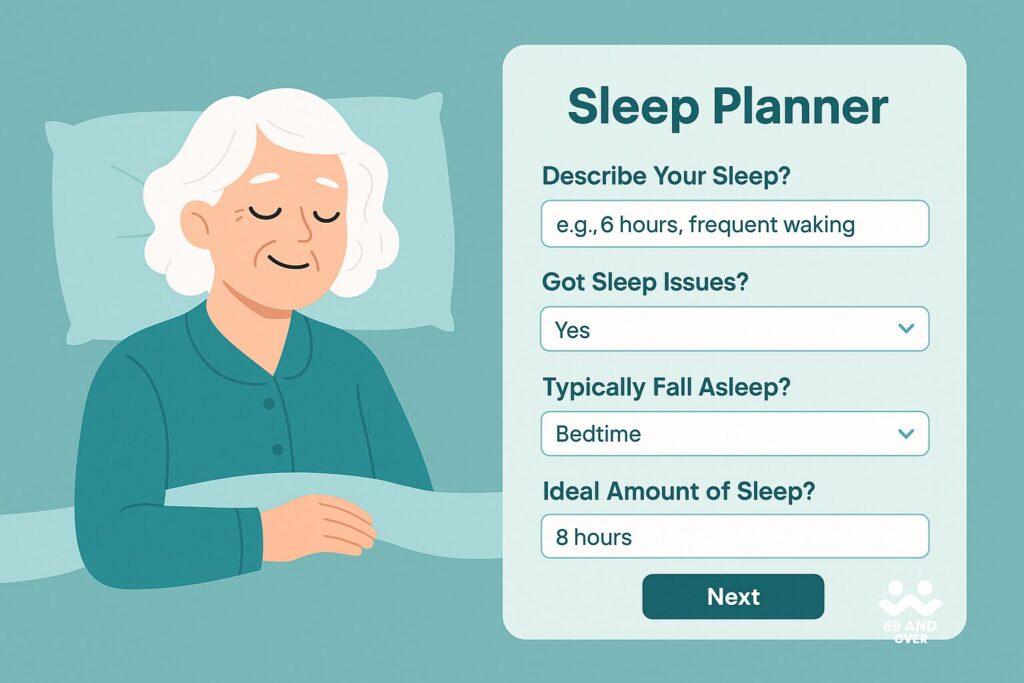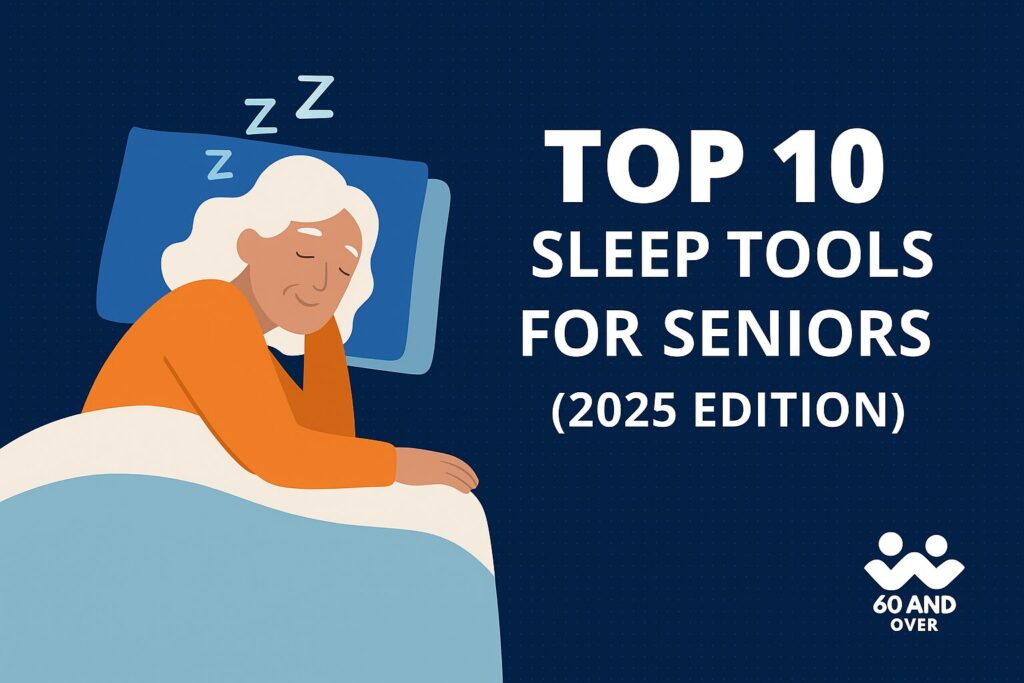Sleep challenges are common after 60. Many older adults report difficulty falling asleep, waking too early, or lying awake for long stretches during the night. While some turn to over-the-counter supplements or prescriptions, one of the most effective—and safest—treatments doesn’t involve pills at all. It’s called CBT-I (Cognitive Behavioral Therapy for Insomnia).
CBT-I is recommended by sleep specialists as the first-line treatment for chronic insomnia, even for seniors. This guide explains what CBT-I is, how it works, what to expect, and why it’s often the best starting point before considering sleep medications.
What Is CBT-I?
CBT-I (Cognitive Behavioral Therapy for Insomnia) is a structured, short-term program designed to improve sleep by changing unhelpful thoughts and habits that keep you awake.
Instead of masking insomnia with medication, CBT-I targets the root causes:
- Worrying about not sleeping.
- Irregular sleep schedules.
- Habits that disrupt sleep (e.g., late-night TV, naps).
Typically, CBT-I is delivered by a trained therapist over 4–8 sessions, either in person, by phone, or through an online program.
Why Seniors Benefit from CBT-I
Older adults often take multiple medications (polypharmacy), which increases the risk of side effects from sleep drugs. CBT-I avoids these risks entirely while still being highly effective.
Key benefits for seniors:
- No medication risks: Safe for those with heart conditions, balance issues, or memory concerns.
- Proven effectiveness: Research shows CBT-I works as well or better than prescription sleep aids.
- Sustainable: Skills learned can last for years, unlike pills that stop working when discontinued.
- Customizable: Techniques can be adapted to your health, routine, and living situation.
Core Techniques in CBT-I
1. Sleep Restriction Therapy
It may sound strange, but one of the first steps is limiting the amount of time spent in bed. If you’re only sleeping 5 hours but staying in bed for 8, CBT-I temporarily “restricts” your bedtime to match actual sleep. Over time, as sleep becomes deeper and more efficient, your sleep window is gradually expanded.
2. Stimulus Control
The bed should be associated only with sleep (and intimacy). That means:
- Go to bed only when sleepy.
- Get up if you can’t sleep within 20 minutes.
- Avoid reading, TV, or phones in bed.
This retrains the brain to link bed with rest, not frustration.
3. Cognitive Restructuring
Many seniors lie awake worrying: “If I don’t sleep, I’ll be exhausted tomorrow.” These thoughts increase anxiety, making sleep even harder. CBT-I teaches how to challenge and replace these unhelpful beliefs with more realistic ones, reducing nighttime stress.
4. Relaxation Training
Simple relaxation techniques help calm the body before bed:
- Deep breathing.
- Progressive muscle relaxation.
- Mindfulness meditation.
5. Sleep Hygiene Education
CBT-I reinforces healthy routines such as:
- Keeping a consistent wake-up time.
- Limiting caffeine and alcohol.
- Getting natural light exposure during the day.
What to Expect in a CBT-I Program
- Assessment: The therapist asks about sleep patterns, habits, and medical history.
- Sleep Diary: You may be asked to track your bedtime, wake time, naps, and sleep quality.
- Weekly Sessions: Most programs involve 30–60 minute weekly meetings for 4–8 weeks.
- Homework: You’ll practice techniques like adjusting bedtime or relaxation exercises at home.
- Results: Many seniors notice improvements within 2–3 weeks.
Can CBT-I Be Done Online?
Yes. Online CBT-I programs (sometimes called digital CBT-I) have grown in popularity. Seniors who can’t easily attend in-person sessions can use apps or web-based programs guided by trained providers. Studies show online CBT-I can be nearly as effective as face-to-face therapy.
Risks or Downsides
- Initial fatigue: Sleep restriction can feel tough at first. You may feel sleepier before sleep efficiency improves.
- Commitment needed: CBT-I requires active participation—tracking sleep, sticking to a routine, and doing homework.
- Availability: Not all areas have trained providers, though online options help bridge the gap.
Despite these hurdles, CBT-I remains one of the safest, most effective insomnia treatments for seniors.
Our Take
If you’re over 60 and struggling with sleep, CBT-I should be your starting point. It teaches long-term strategies that work without the risks of medications. While supplements like melatonin or prescriptions like ramelteon can be useful in certain cases, CBT-I is the gold standard for building healthier sleep habits that last.
“This guide is part of our Complete Guide to Sleep Aids for Seniors, where we cover safe options and tips to improve sleep after 60.”
FAQ: CBT-I for Seniors
Q: How long does CBT-I take to work?
A: Most seniors notice improvements in 2–3 weeks, though full benefits may take 6–8 weeks.
Q: Does Medicare cover CBT-I?
A: Some Medicare Advantage plans may cover CBT-I if delivered by a licensed provider. Coverage varies, so check with your plan.
Q: Can I do CBT-I on my own?
A: While you can practice some techniques like sleep hygiene or relaxation, structured CBT-I works best with a therapist or guided program.
Q: Is CBT-I safe for seniors with medical conditions?
A: Yes. Unlike many sleep medications, CBT-I has no drug interactions. However, programs can be tailored if you have mobility or cognitive challenges.
Q: What if I still can’t sleep after CBT-I?
A: If insomnia persists, your provider may combine CBT-I with other treatments such as melatonin, light therapy, or in rare cases, short-term medication.
Disclaimer: This article is for educational purposes only and is not medical advice. Ramelteon is a prescription medication and should be used only under the guidance of a licensed healthcare provider. Seniors should speak with their doctor before starting, stopping, or changing any sleep aid or prescription. Read our full disclaimer





